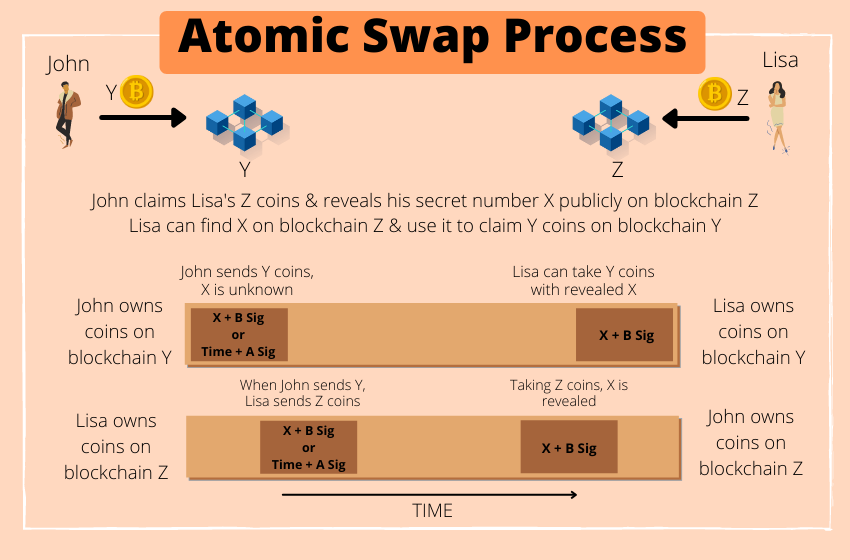Cryptocurrency has been constantly getting its shape and expanding in terms of its meaning. There have been a lot of inclusions off late. One of such important inclusions in the cryptocurrency space just like the smart contracts are the atomic swaps. This article dives into the actual meaning of the atomic swap, stressen on how the technology works, and offers a brief history of the technology development.
What Are Atomic Swaps?
You might have after a point questioned yourself “what is atomic swap in cryptocurrency?” after you have come to know the name. Here is what you need to know. An atomic swap can be defined as a smart contract technology enabling the exchange of a certain cryptocurrency for another without making use of the centralized intermediaries such as the crypto exchanges. The trustless atomic swaps are capable of taking place directly between the blockchains of various cryptocurrencies. Simultaneously, they can also be conducted off chain which will be away from the main blockchain.
The atomic swaps are often termed as the atomic cross chain swap or trading that completely eliminates the requirement of the centralized third-party entities while it is executing a trade. It permits the users to trade directly from their own crypto wallets. This offers the system an opportunity for preserving the autonomy of the cryptocurrency users and aids in trustless transactions where the users remain anonymous and are devoid of the counterparty risks. Owing to this trustlessness and peer-to-peer nature of the atomic swaps, they are widely considered as one of the few genuinely decentralized trading techniques.
The centralized exchanges do not permit the users to retain the custody of their private keys. This means that the users do not in reality own their tokens and coins. If the exchange gets compromised, there remains a little option for the users who had their coins on the exchange and that they are stolen.
This is where the atomic swaps are most important. There are two basic reasons that let the atomic swaps take up the step. The very first is that it permits the users to keep control of their funds and their private keys all the time. The other reason is that there is really no increase in the security risk while you are performing an atomic swap. The risk is no doubt the same as storing your tokens and coins in any of the hot wallets or online wallets.
However, the safest method to store your digital currency is in a wallet that has never indulged in any transactions. This means that the wallet is completely virgin and that it has never received coins or sent any. We are talking about cold wallets or hardware wallets. But this method of storing your coins does not permit any type of trading. As soon as you send your coins from a specific address, the storage or the wallet is no longer considered as cold. Thus, if you want to exchange your tokens or coins in exchange of any other cryptocurrency, the atomic swap mode of trading is the most secure option.
A Brief History Of Atomic Swap
We will definitely discuss atomic swap trading. But it is important to know about the history and the origin of the atomic swaps.
The concept of the peer-to-peer (P2P) and trustless cryptocurrency trades has been a topic of public discussion since the year 2012. Sergio Demian Lerner, a developer, created the very first draft of a trustless exchange protocol back in July 2012. This was considered a good start, however, the concept did not completely flesh out.
In the following year, in May, Tier Nolan had provided the first complete account of a procedure for the atomic swapping. He had been widely credited with being the atomic swap inventor. At this point, the idea of the atomic swap was a bit more than just an idea. Everyone trusted the benefits that such a crypto trading mechanism is about to introduce. Unfortunately, no one had written the exact code for making the atomic swaps possible.
In May 2014, after Tier had presented the idea of the atomic swap protocol, several developers had started their own way of coding atomic swaps. They started to experiment with the protocol. Evidence stated that Litecoin, Bitcoin, Decred and Komodo communities have all played an important role in the process.
The first atomic swaps started to take place in 2014. However, it was only in 2017, the technique had become famous and widely known by the general public. This is owing to the successful swaps between the DCR/LTC and LTC/BTC. A few days later after the Decred team had completed an atomic swap between the Litecoin and Decred, Charlie Lee, the founder of the Litecoin tweeted that the process had successfully been replicated for a litecoin-to-bitcoin trade.
In this regard, this is to be noted that the actual design of the atomic swap seeked both the parties to download the entire blockchains of the coin that they had planned to trade. This is known as on-chain atomic swap. A month followed by the Decred and Charlie Lee’s first executed sets of atomic swaps, Komodo had introduced a “Light Mode” version. This version of Komodo atomic swap only needs special payment channels that are offshoots of blockchain. After this version launch, the traders need not have to download the complete blockchains of their preferred coins or await the finalization of the transactions.
How Do Atomic Swaps Work?
The term “Atomic” is a terminology that has been used to connote the processes that would either not initiate at all or finalize. In simple words, an atomic swap bears certain functionalities that ensures that both sides of the trade fulfills all the predefined conditions prior to the completion of the trade. This is however, made possible by the integration of the smart contracts that are self initiating programs enforcing the conditions governing the success of any transaction.
If we would be more specific, this can be stated that anatomic swap makes use of an Hashed Timelock Contract or HTLC. This functions as a bi-way virtual safe. As the name suggests, the contract utilizes a much more sophisticated mathematical based encryption termed as a hash function. Additionally, it introduces a time constraint so that the transactions are reversed when either of the partiers in a transaction does not fulfill their sides of the bargain within a predefined time.
For instance, the two parties involved in a transaction might agree to set an hour of time constraint for the atomic swap. In such a scenario, the contract will return the deposited copins to their actual owners when an hour elapses and that not all of the trading conditions have been met.
Another crucial detail that you need to know about HTLC is that it needs two cryptography keys or encrypted keys such as:
- Hashlock Key: This key makes sure that the trades are solely finalized when both the parties submit cryptographic proof that they have fulfilled their part of the transaction.
- Timelock Key: This key has been designed as a safety mechanism helping the traders to set a deadline for the atomic swaps. The mechanism makes sure that the deposited coins are returned to the traders when the swap remains incomplete for a reason or other prior to the elapse of the deadline.
The atomic swaps can occur in two different methods – on chain and off chain. The on-chain atomic swaps take place on either of the currency’s networks. On the contrary, the off-chain atomic swaps take place on a secondary layer. Such kinds of atomic swap is generally based on the bi-directional payment channels. This is similar to the ones that are used in the Lightning Network.
Speaking technically, most of these trustless trading systems are based on the smart contracts (atomic swap smart contract) utilizing multi-signatures and the HTLC.
Practical Example Of Atomic Swap
In this segment we will explain the atomic swap process in detail through an easy atomic swap example. Assume that John and Lisa wish to exchange cryptocurrencies utilizing an atomic swap.
- John deposits his crypto coin into an HTLC address that acts like a virtual safe. It can only be opened with a special key that he can access.
- John shares a cryptographic hash of the special key with Lisa, who deposits her cryptocurrency into an address that has been created utilizing the same cryptographic hash.
- As soon as Lisa deposits her cryptocurrency, John can use the virtual coin by “unlocking” the transaction with the special key that has been obtained from his initial deposit.
- After John has used the key to unlock the transaction, Lisa can get access to her share of the exchange.
- After both the parties have access to their individual funds, the atomic swap can be termed as “Completed”.

Pros Of Atomic Swaps
Below are the advantages of using atomic swaps for trading in the blockchain.
Decentralized
The crypto traders tend to advocate for the decentralized financial world yet still need to trade using the centralized exchanges like the Coinbase. Being independent of the crypto exchange platforms and permitting for the direct as well as wallet-to-wallet transactions, the atomic swaps offer the traders complete control over the exchanges and their accounts. In this regard, an atomic swap wallet does exist. The atomic swap fees are also levied on the wallet.
Increased Security
The timelock and the hashlock technologies in the HTLC contracts that are employed by the atomic swaps provide assurance and greater security to the traders as they have guarantee of receiving their currency back in case of conflicts or delays and they have complete control over their transactions.
Lower Costs and Peer-to-peer Trading
The atomic swap permits the people to trade with each other independently and simultaneously reduces the operational costs and the trading fees associated with the use of the centralized exchange platforms.
Increased Flexibility To Trade Altcoins
The cryptocurrency exchange platforms such as Coinbase does not permit the traders to exchange all the types of the altcoins such as Ripple (XRP) which cannot be directly traded for Litecoin on the Coinbase platform. In such a scenario, it must be converted to Bitcoin (BTC) and then one can attempt to convert into Litecoin (LTC). Atomic swaps are capable of solving such a problem by permitting nearly all types of the altcoins that seek trading.
Cons Of Atomic Swaps
The following are the disadvantages of the atomic swap.
Conditions & Complexity
As the atomic swaps offer higher security, they have come with the trading conditions that are more rigid than those that are imposed by the cryptocurrency exchanges. Additionally, the technique also calls for parties to interact without the means to directly communicate. For instance, the platforms might execute trades with just a click of a button. On the other hand, the atomic swaps need exchange of information and data along with the hashed cryptographs.
Issues With Privacy
An atomic swap can consume time to execute based on the TimeLock’s timeframe. Owing to this, the transaction is active on the blockchain network for a longer period offering the hackers more time to interrupt the process and collect private information about the traders. As one of the prime characteristics of crypto trading is legal anonymity of the transactions, it is a serious issue that needs to be addressed at the earliest.
Absence Of A Centralized Platform
Irrespective of all the disadvantages that are associated with utilizing the centralized platforms, the atomic swaps never offer the same amount of convenience that the trading platform offers. This is especially when it comes to exchanging the fiat currency for cryptocurrency that cannot be carried out via the atomic swaps.
Why Do Atomic Swaps Matter In Cryptocurrency?
Atomic swaps bear great potential to improve the crypto space and still await testing on a broader scale. Cross-chain trading, eventually, can solve several problems that are a part of the most centralized exchanges. However, these exchanges have maintained the crypto system till date, but there are several concerns related to them. Some of the issues are:
Greater Vulnerability
Storing many valuable resources in just a single location makes them prone to hacking. It is a fact that the centralized cryptocurrency exchanges are the main targets for virtual currency heists.
Funds Mismanagement & Human Error
The centralized exchanges are run and managed by people. If those individuals that are placed to perform important roles make any mistakes or if they make meagre choices in regards to the exchange operation, then the funds of the users can be compromised.
Higher Operational Costs
The centralized exchanges possess relatively higher trading and withdrawal fees. The atomic swaps aim to reduce them or make them null by eliminating the centralized platforms. You might also research on the internet regarding atomic swap vs decentralized exchange.
Inefficiency Of The Volume Demands
When the market activity becomes much more intense, the centralized exchanges mostly fail to deal with the rise in trading demand. This causes the system to completely slow down or absolutely go offline.
Regulation
In most of the countries, the crypto regulation is far from ideal. There still exist many concerns revolving round the management and government approvals.
The Closing Thoughts
The atomic swaps are yet fairly new and there exists specific limitations. Nevertheless, the technology is driving efficient changes in accordance to the blockchain interoperability and the cross-chain trading capabilities. In such a case, the technique possesses great potential for influencing the growth of the cryptocurrency industry.
Additionally, it also opens up new routes in terms of decentralization and P2P monetary transactions. The chances are that the atomic swaps are likely to be used even more in the near future, specifically within the decentralized exchanges. Atomic swap exchanges are pretty familiar these days and you can choose the best atomic swap exchange as per your preference.
- Bitcoin DCA: A Beginner’s Guide To Make Your Investments Easy - 27/03/2025
- 6 Most Funny Bitcoin Stories You Will Ever Know - 27/03/2025
- Easy Definition And Uses Of Crypto Regulatory Sandbox - 03/08/2024
 Crypto Venture News One stop Crypto Track Down
Crypto Venture News One stop Crypto Track Down 






